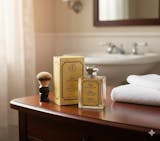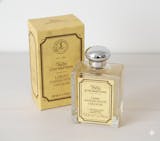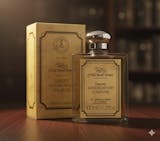Alum Blocks for Wet Shaving (How to Use Them and Why)

I still remember a gift a colleague gave me while on a business trip to Hong Kong—an alum block. I didn't know what it was at the time or how to use an alum block, but it proved to be one of the most useful gifts for traditional wet shaving I've ever gotten.
I've since learned that achieving the perfect shave is all in the follow-through. Although it could be easily overlooked, the post-shave routine is just as important as the shave itself, and the alum block is an essential part of that.
- What is an Alum Block?
- The History of the Alum Stone
- What is Alum Used For? The Benefits and Uses of an Alum Block
- How to Use an Alum Block
- Alternatives to Alum Blocks for Wet Shavers: The Styptic Pencil
- How to Use a Styptic Pencil
- Alum Blocks Frequently Asked Questions
What is an Alum Block?
 Osma Alum Block, a natural crystal for post-shave care.
Osma Alum Block, a natural crystal for post-shave care.
Photo by Dovo
An alum block is a crystal-like stone in the shape of a miniature bar of soap, also known as an alum stone or alum crystal, a mineral block made from potassium alum, a naturally occurring mineral and composite known for its antiseptic and astringent properties.
Historically used by the ancient Egyptians, potassium alum was employed more than 4,000 years ago for its antiseptic and healing properties, as well as to cool and revitalize the skin.
Available in various shapes and sizes, including alum bars or crystals, there are convenient travel-size alum sticks for precise application.
The alum bar is today utilized as a wet shaving essential in the post-shave process to cool and refresh the skin after shaving, wetting it with water and gently rubbing it over the shaved area to minimize redness and soothe irritation, limit the appearance of razor bumps, fight razor burn, and heal minor nicks and cuts.
Due to their antibacterial properties, alum blocks can even help tighten pores, kill surface bacteria, and reduce the appearance of pimples and acne.
The History of the Alum Stone
 Ancient Egyptians used alum stone for healing and cooling.
Ancient Egyptians used alum stone for healing and cooling.
Original photo by ArtsyBee on Pixabay | Edited by Naked Armor
People have consistently sought better therapeutic remedies. In addition to being found at many archaeological sites in Egypt, the mineral block has also been discovered in sites that suggest they were also used in Ancient Greece and Rome.
The original alum block enthusiasts were actually the ancient Egyptians. More than 4,000 years ago, the Egyptians discovered the antiseptic and healing properties of the mineral. Although our image of the ancient Egyptians might not necessarily align with a concern for a hedonistic pursuit of comfort or vanity, they knew that the alum block felt really good and cooled their face in the heat. That's all it took for the practice to become commonplace.
The Ancient Greek historian Herodotus wrote that Egyptian alum was a valuable commodity back in his day. Similarly, the Ancient Roman historian and army commander Pliny the Elder documented that the Romans used the substance in their medicine and for dyeing fabrics. During the Islamic Middle Ages, alum was used extensively as a "mordant"—a chemical that helps dyes set into fabrics.
What is Alum Used For? The Benefits and Uses of an Alum Block
 Captain Fawcett Traditional Alum Bar, the classic post-shave remedy.
Captain Fawcett Traditional Alum Bar, the classic post-shave remedy.
Photo by Captain Fawcett
- Increase grip on slippery safety razors or straight razor handles
- Treat minor nicks and cuts
- Fight razor burns
- Improve skin tone
- Reduce skin inflammation
- Address post-shaving-related skin irritation
- Reduce the appearance of razor bumps
- Heal minor bleeding by constricting blood vessels and tightening pores
- Replace your favorite scented deodorant
- Clear up pre-existing skin conditions like acne or spotty skin for a better appearance
- Reduce the risk of developing ingrown hairs
- Calm the skin and avoid razor bumps for women after waxing sensitive areas
When using an alum block, you'll find that it tightens pores and constricts blood vessels to do its job. It's a coagulant that thickens blood cells to stop bleeding, while simultaneously providing a soothing, cool, and refreshing sensation on the skin. It also kills surface bacteria.
Surprising as it may be, alum's versatility doesn't stop there: it's also a great natural deodorant. It's not a better first choice than your favorite scented deodorant, but all those crystal deodorants in the store are slightly refined versions of a pure alum block.
The crystals come in different shapes and sizes. You can opt for a large block if you're using it at home as part of your regular shaving routine, but you can also choose a smaller bar for travel or for more precise application.
The type of razor you use to shave doesn't affect the post-shave routine. An alum block should be part of every traditional wet shaving kit, regardless of the razor you choose.
How to Use an Alum Block
-
Step 1
After finishing shaving, wash your face to remove any remaining soap or shaving cream residue. Splash your face with cold water. This helps to close and tighten pores, allowing the alum block to glide smoothly over your face. Just gently rubbing the wet alum block on your skin will lightly exfoliate your pores.
-
Step 2
Wet the alum block with cold water before applying it to your face. Ensure the entire surface is thoroughly wet.
Pro tip: Soak an alum block in ice water before use for an enhanced cooling sensation—especially if you're prone to nicks, cuts, or razor burn. Or, if the razor blade wasn't as sharp as you would have liked, you might want to revisit our previous post on how often you should change your safety razor blade.
-
Step 3
Gently massage the block across the areas of your neck and face that you shaved. Rub gently because of its astringent qualities, and you should expect to feel a bit of tightness and tingling or a mild burning sensation. This is expected; it's just the alum crystal and the salicylic component of natural potassium alum at work.
-
Step 4
Let the alum residue sit on your skin for about 15 to 20 seconds—roughly the same amount of time it takes to sing Happy Birthday twice or the ABC song. This allows the crystals to shrink your pores and sanctify your skin. Then rinse the residue off with cold water.
If you have sensitive skin, do not leave the alum block on for more than 20 seconds.
-
Step 5
Apply moisturizer to your freshly shaved skin and use an aftershave balm or product as needed, such as a high-quality, moisturizing cream, aftershave, or shave balm with natural ingredients.
Alternatives to Alum Blocks for Wet Shavers: The Styptic Pencil
The most popular alternative to alum blocks is the healing styptic pencil, also known as an alum pencil or alum pen.
A styptic pencil is a medicated stick made from the same compounds as the alum block, but in a compact form, making it a great addition to your travel dopp kit. The pencil is just in a powdered form and has a wax binder, all compressed into a lipstick-sized compact shape.
Because it has a small tip, it's much easier to target a specific nick or cut with a styptic pencil than it would be with a big alum block. The military even uses styptic pencils to help stop bleeding. They generally work better for minor cuts than Band-Aids, which can trap bacteria and fester.
How to Use a Styptic Pencil?
-
Step 1
Finish shaving and rinse your face with cold water to close up your pores.
-
Step 2
Wet the styptic pencil and gently apply it to your face with a light touch, but not too much pressure, to treat nicks and shaving cuts and to stop any bleeding. You might feel some stinging here, but that's a sign that the pencil is doing what it's intended to.
-
Step 3
Unlike the alum block, you don't wash off the pencil residue after just 15 or 20 seconds. The pencil residue should stay on your face for a few minutes, allowing it enough time to seal the cuts. Ensure the bleeding has completely stopped before wiping it off your face.
Alum Blocks Frequently Asked Questions
Why is the alum block so popular right now?
There has been a lapse in the everyday use of the alum block in the ordinary man's shaving routine, but it was popular just a few decades ago.
They're generally seen as an old-school wet shave accessory. Still, they're becoming trendy again as an all-natural treatment among a growing number of men who are becoming more intentional about their shaving habits.
The alum block, also known as alum stone, has since been used by barbers and adopted by the shaving community as an essential step in the post-shave process. Simply put, an alum block should be part of every man's shaving kit, whether shaving with a safety razor or a straight razor.
How do you store an alum block?
After you're finished, rinse the alum stone with cold water to ensure it's thoroughly cleaned. Then dry the alum block completely with a dry towel and store it in a cool, dry place where air circulation is possible. The block must be completely dry—if the potassium alum retains moisture, it will start to dissolve, and its lifespan will be shortened. If your alum came with a plastic case, use that for storage.
Can you use alum every day?
You can. Please note that if you have dry or sensitive skin, it may cause your face to dry out. For people with oily complexions, it's probably fine. Alum is an astringent, which means it will draw moisture from the skin.
Even if your skin isn't particularly sensitive, it's best to use it no more than twice a day. If you use alum frequently, you may find that your skin overcompensates for the antiseptic properties by producing more oil than it would naturally. Please don't do it too much; you don't want greasy skin.
How long does an alum block last?
The lifespan depends on the size of the alum stone, its frequency of use, and the storage conditions. If you have a standard 50- to 70-gram block and care for it properly, using it once a day, you can expect it to last two years or more.
Can I use both alum and aftershave?
Some people like to use both, and others don't. It's a matter of personal preference. Some people find that alum's astringent properties and the alcohol content of aftershaves tend to dry out their skin. It's worth testing alum block shaving on its own, then with aftershave to see what works best for your skin.
Can you use alum blocks as a natural deodorant?
You can actually use it under your arms as an alternative to traditional deodorant. It's often marketed as "crystal deodorant." It's not an antiperspirant, so it won't stop you from sweating, but it might help prevent odors, depending on how your body's chemicals interact with the mineral salts. Try it out after your next shave.
Where can I buy an alum block?
Alum blocks come in various forms, such as blocks and pencils, and are sometimes even infused in shaving soaps. Online shops that sell professional shaving products and kits will sell alum blocks. Make sure to purchase a high-quality alum stone, as poorly made alum stones can start falling apart bit by bit, leaving you with only a pile of dust. In contrast, a finely made alum bar can be used for years. Search for the pre- and aftershave sections of products and choose the best size based on your lifestyle and the frequency of shaving.
Related Articles
How to Stop a Shaving Cut and Nicks From Bleeding
The Burning Question: How Long Does Razor Burn Last?
Best Aftershave for Men No Matter Your Skin Type




























Leave a comment